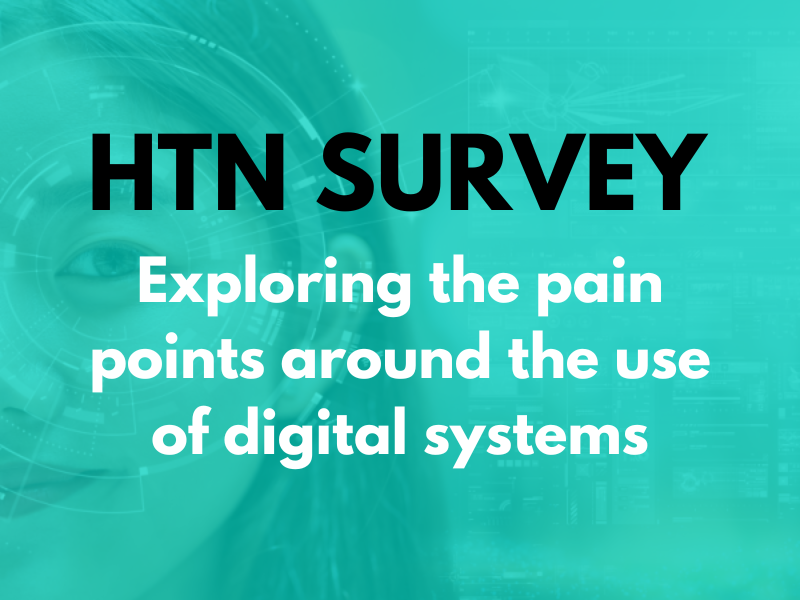For a recent HTN Now webinar, we explored the impact of EPMA, taking a closer look at its role in increasing efficiency and accuracy in prescribing, in improving patient safety, and some of the challenges with introducing and implementing EPMA systems. Our expert panellists, Fhezan Ashraf, senior pharmacist clinical configuration manager at The Dudley Group; and Hui Yi Lee, advanced clinical pharmacist & EPMA clinical lead at Essex Partnership University NHS Foundation Trust (EPUT) shared their own experiences and insights, detailing outcomes, challenges, engagement, design, interoperability and training.
Fhezan shared how his journey began in 2019 with the rollout of order comms and ED clinical documentation, before launching into EPMA with a big bang rollout in August 2020 across all adult inpatient areas. “It was a huge effort from an operational, clinical and digital perspective,” he said, “and now we have an integrated EPMA solution within our EPR, we’ve expanded the drug catalogue to include prescribing for 16 and 17-year-olds, and we’re looking at outpatient prescribing right now.” As part of this rollout, Dudley also introduced an electronic discharge notification.
Hui told us how she started at EPUT two years ago, after previously working as lead pharmacist for EPMA at Dartford and Gravesham. EPUT has selected EMIS’s rebranded Optum EPMA, she highlighted, “and as we’re a mental health trust our sites are pretty spread out, but we have successfully rolled out to 43 inpatient wards within six months, which is quite an achievement”. Next, the trust is looking at is working with Mid and South Essex NHS Foundation Trust on a unified patient record, offering one patient record across acute, mental health, community and GP settings.
Approaches to EPMA rollout
Hui reflected on the beginning of the rollout at EPUT, and how the trust decided where it should start to focus its efforts. “We did some pilot selection with ten criteria, looking at things like capacity, IT infrastructure, and patient turnover – we tried to avoid rapid turnover as that would make the transcribing more difficult to keep up with,” she said. “Location was also quite important for us, as we tried to provide neighbouring support, and we didn’t want to roll it out to one ward and then jump over to another site.”
The team ended up starting with the dementia ward, Hui shared, which granted exposure to lots of patients with complex medication, along with a general mental health ward, and a specialist ward to see how it would work in a smaller setting that may have certain medications which could be harder to transcribe.
In Dudley’s case, the choice of the big bang approach was inspired by not wanting a “dual economy”, Fhezan explained. “We had transcription teams stood up consisting of pharmacists and doctors, who effectively managed to transcribe around 700 patients overnight in a huge coordinated effort.” A command centre was set up with gold, silver and bronze standards to cover escalation issues, “and we just wanted to get it over the line as soon as possible to start reaping the benefits of the solution”.
Overcoming challenges
The number one challenge for the project has been resources, Hui said, “we have a very small team – five of us in total, plus a system administrator, so we have to plan very carefully in terms of what we can achieve”. She also noted issues around the interface with the PAS, particularly around pulling in patient information when working with two different systems from two different suppliers. “It’s a big challenge for us to reach a stage where we can have information flowing smoothly.”
Further challenges relating to hardware and logistics have also become evident, Hui shared. “If you want to implement digital change, it’s important to know whether there are enough sockets before you send lots of laptops over, or to be sure of a secure Wi-Fi connection.” Before starting a digital project of this kind, speak with staff to gain insight into this, she considered, “and we have to spend a lot of time doing this prep work before we start the rollout process.”
Fhezan talked about some of his own experiences around challenges with EPMA implementation. “My advice would be to make use of workshops, and include representatives from multidisciplinary teams,” he said. “We’ve also experienced challenges with medicines reconciliation. Our system does have a specific reconciliation function, but implementation was difficult, and we had to work with our supplier to make some updates.”
The patient journey just from ED to inpatient is effectively two separate visits with two separate charts, Fhezan explained, “and that’s still a challenge to this day, although we have made some improvements”. He also recommended process mapping, taking into account the behaviours and processes involved, working closely with suppliers, and making sure before going live that different scenarios have been throughly tested. “For us, it was adapting a system to fit in with our workflows, which are definitely not linear – focus on your pathways, your journeys, and don’t underestimate that at the start.”
Measuring success
“It’s very apparent that processes have become much more visible in terms of what staff are actually doing,” Hui noted. “Previously, different wards were doing things in different ways for things like patient discharge, and implementing EPMA has meant there is only one way to get patients into the system.” Whilst this was “quite tricky” for the first few months whilst people were getting used to the system, it has helped reduce errors.
The system also provides a desktop view for nurses showing all due doses, Hui told us, “which allowed us to massively reduce the amount of mis-doses, because nurses don’t have to go through every single chart to find out about doses becoming due”. The ability to click a button and enter a supply request has been popular amongst nurses in particular, she shared. “That has again helped us reduce mis-doses, as pharmacy can easily navigate to nurse supply requests and check them, which makes the administration and supply side of things a very linear process, easy to follow and to be followed-up.” For audits, this serves to make it easier to investigate if errors do happen, she concluded, “because we can actually track down when things have happened, and who was responsible, making the whole investigation shorter”.
At EPUT there are four designated trainers for the EPMA system, Hui told us. “We had feedback that face-to-face was the best way to approach training, so we focused on that but also had parallel online learning available. We set up sessions back-to-back for doctors, nurses, pharmacists, nurse administrators, and anyone else with involvement, and our phased approach meant we could do batch training and batch rollout to different places.” Now the team is looking to develop its online learning offering, with the idea that those who have been trained face-to-face will be able to pass on their knowledge to newcomers, who will mainly be trained online, with drop-in sessions twice per month.
“Our pharmacy, digital medicines pharmacists and pharmacy department work really closely with our informatics team,” said Fhezan. “We have a powerful BI dashboard, where there’s a plethora of data, and that’s allowing conversations about how that data can be engineered to add value. If you look back to paper audit days, this data eliminates so much of that time taken, to free up time for staff to spend with patients.” The dashboard offers functions such as data at ward level, he continued, “and that data, along with the impact on minimising errors, has been where we’ve seen the biggest benefits”.
Add-ons and integrations
Fhezan discussed The Dudley Group’s current capabilities in terms of decision support, with allergy checking forming part of the point of prescribing, meaning the system will give a warning if patients have allergies recorded. “We’re currently looking at the idea of duplicate checking,” he shared, “and that isn’t live yet – we don’t want to fatigue clinicians with alerts, but we have brought in a few tweaks over the years like for VTE, where the system reminds the prescriber and guides them through the assessment.” The system also has dosing support for insulin, generating an alert if a higher-than-expected dosage of insulin is recorded or prescribed.
“We’re similar,” agreed Hui, “but we’ve made it mandatory for a prescriber to input a reason when there is an allergic reaction, and we’ve also introduced alerts around duplicate medication.”
When it comes to integration with EPS, EPUT uses SystmOne in outpatients, which comes with an EPS solution, Hui explained. “It’s just the inpatient side that doesn’t have EPS, and that’s something we really wanted to do, but we’ll just have to wait for direction from suppliers to see when they will have that capacity to put it on their roadmap.”
“We don’t have timescales for that either,” said Fhezan, “but we’re looking to digitise our internal outpatient prescriptions right now, so I’m in conversations with our supplier to make sure we design the architecture for that prescribing with a forward view to rolling out EPS in the future.”
Next steps and future plans
Hui discussed how her teams most likely next steps involve testing and checking BAU processes, going back over training, and looking at finer details such as whether new accounts can be created quickly enough to deal with clinical rotations. “This is also the time we’ll start reaping the benefits,” she considered,” and one of the main things we’ll be looking at is clinician time saved, doing time in motion studies, investigations around reducing the amount of paper being scanned back to the EPR system, and exploring how much money we’re actually saving.”
EPUT has a unified EPR coming soon, Hui went on, “so a lot of our expertise will be pulled over to that new project, and a lot of our learning from EPMA will be relevant”. The new EPR programme includes an EPMA system, she shared, “which will mean spending a lot of time basically doing everything again, the drug configuration, the process mapping, the testing, and so on, to allow us to roll that out at the beginning of 2027”.
Over the next 12 months at The Dudley Group the team hope to have enabled outpatient prescriptions, with EPS being a goal for the next couple of years, Fhezan explained. “We want the ability to start medicines reconciliation from the emergency department visit, and for that to then seamlessly move over into the inpatient visit. That’s something that we’re currently engaged with our suppliers on.”
We’d like to thank Fhezan and Hui for joining us to share their insights on this topic.





